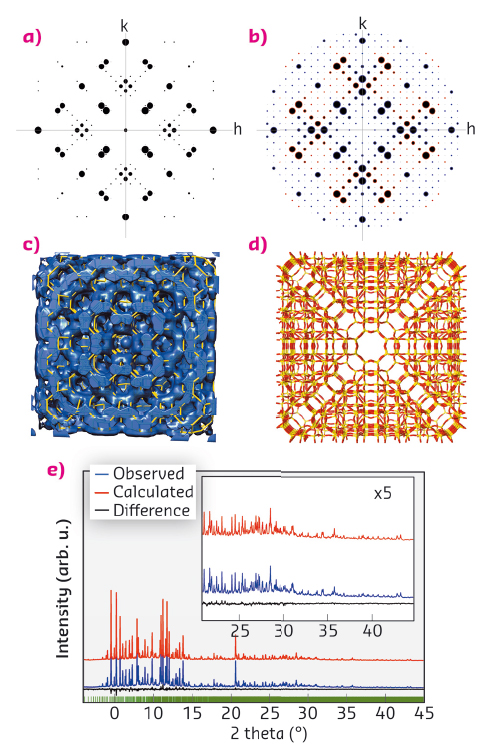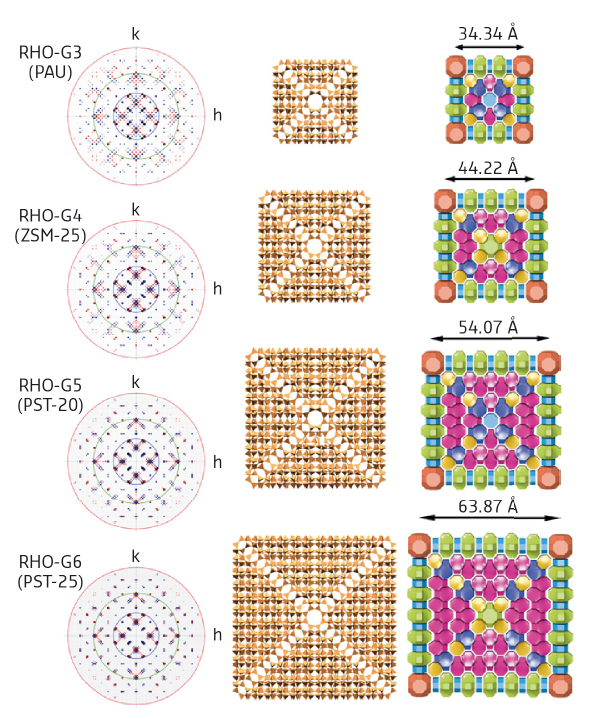- Home
- Users & Science
- Scientific Documentation
- ESRF Highlights
- ESRF Highlights 2015
- Structure of materials
- Unravelling the structural coding of a complex zeolite family
Unravelling the structural coding of a complex zeolite family
A new approach that combines structure solution with structure prediction, and inspires the targeted synthesis of new super-complex zeolites has been developed. High-resolution powder X-ray diffraction (PXRD) combined with rotation electron diffraction was key to the determination of complex zeolite structures ZSM-25 and PST-20, which have shown very attractive CO2 adsorption properties.
Zeolites are widely used in industry for gas separation, catalysis and ion-exchange because of their well-defined pore structures. Until recently, zeolites were mainly discovered using a trial-and-error synthesis approach whereby it was difficult to know in advance exactly which new zeolite structure the synthesis may produce. Furthermore, zeolites are synthesised as polycrystalline crystals, too small or too complex to be solved by X-ray diffraction. One such example is the aluminosilicate zeolite ZSM-25, first reported in 1981 [1], but the structure remained unknown.
We have developed the rotation electron diffraction (RED) method for collecting 3D single crystal electron diffraction data from micro- and nano-sized crystals [2]. RED data of ZSM-25 was collected from a crystal of 250 nm in size (Figure 39a), which revealed that ZSM-25 has a cubic space group Im-3m with a ~ 42.3 Å. However, the low data resolution (~2.5 Å) caused by electron beam damage prevented structure solution using direct methods. By searching in the Database of Zeolite Structures, we found that zeolite RHO and PAU have the same space group as ZSM-25, and the distribution of the strong reflections of ZSM-25 is the same as those calculated for RHO (a = 15.0 Å) and PAU (a = 35.0 Å) (Figure 39b), indicating the RHO, PAU and ZSM-25 structures are related. Strong reflections represent the main structure features of a crystal and can be used for structure solution. We chose the 21 strongest reflections from RED data and assigned their phases to be those of PAU. All 16 symmetry-independent T-atoms (T = Si, Al) were located from the 3D electron density map calculated from the 21 reflections (Figure 39c). A rough structural model with oxygen atoms placed between the T-atoms was built (Figure 39d). To obtain accurate atomic positions and locate the guest species in the pores, high-resolution PXRD data of ZSM-25 was collected at beamline ID31 (now ID22), which gives narrow peaks with accurate peak positions and intensities. Four TEA+, 13 Na+, and 24 water molecules were located in the asymmetric unit by Rietveld refinement combined with modelling (Figure 39e).
 |
|
Fig. 39: (a) The 2D slice of (hk0) cut from the reconstructed 3D reciprocal lattice from the RED data. (b) Simulated (hk0) diffraction patterns of PAU, with the structure factor phases marked in blue (180°) and red (0°). (c) 3D electrostatic potential map generated by using amplitudes from RED of ZSM-25 and phases from PAU. (d) The framework structure of ZSM-25. (e) Rietveld refinement of as-made ZSM-25. |
PAU and ZSM-25 can be considered as expanded versions of RHO by adding extra pairs of pau and d8r cages (~10 Å) along each unit cell edge (Figure 40). We call this the RHO-family, and denote RHO to be the first generation (RHO-G1), PAU the third (RHO-G3) and ZSM-25 the fourth (RHO-G4) generation. We anticipated that the structural relationship (structural coding) of the members would also be reflected in reciprocal space, and that this could be exploited for structure prediction. We found that the framework of ZSM-25 could be predicted from the PAU framework by only using the intensities and phases from the strong reflections of PAU. Similarly, higher generations of zeolite members were predicted, from RHO-G4 (ZSM-25) to RHO-G5 and from RHO-G5 to RHO-G6 (Figure 40). All the members are related by hitherto unrecognised structural principles; we call these embedded isoreticular zeolite structures.
 |
|
Fig. 40: Comparison of the reflection distributions and framework structures of RHO-G3 to RHO-G6. The (hk0) reciprocal plane (left), polyhedral (middle) and tiling (right) representations of cross-sections (about 12 Å thick). |
The structures of RHO-G3 to RHO-G6 are all built of seven cage types, and certain cage types increase more rapidly with the generations. To promote the formation of such cage types, Sr2+ and Ca2+ cations were introduced. RHO-G5 and RHO-G6 could be successfully obtained (denoted PST-20 and PST-25 with a = 55.0664 and 65.0436 Å, respectively), which are the most complex zeolites discovered so far. The structure of PST-20 was confirmed by high-resolution PXRD data collected at ID22 and accurate atomic positions obtained, and the structural model confirmed by Rietveld refinement. In situ studies of the structural changes upon CO2 sorption are now in progress, where high-resolution PXRD is crucial.
Principal publication and authors
A zeolite family with expanding structural complexity and embedded isoreticular structures, P. Guo (a), J. Shin (b), A. G. Greenaway (c), J.G. Min (b), J. Su (a), H.J. Choi (b), L.F. Liu (a), P.A. Cox (d), S.B. Hong (b), P.A. Wright (c) and X.D. Zou (a), Nature 524, 74-78 (2015); doi: 10.1038/nature14575.
(a) Department of Materials and Environmental Chemistry, Stockholm University (Sweden)
(b) School of Environmental Science and Engineering, POSTECH, Pohang (Korea)
(c) EaStCHEM School of Chemistry, University of St. Andrews (UK)
(d) School of Pharmacy and Biomedical Sciences, University of Portsmouth (UK)
References
[1] H.G. Doherty et al., US Patent 4247416 (1981).
[2] W. Wan et al., J. Appl. Crystallogr. 46, 1863-1873 (2013).



